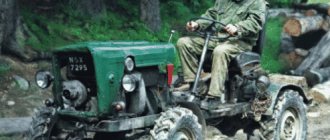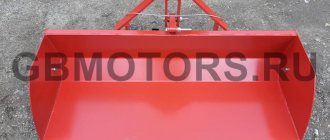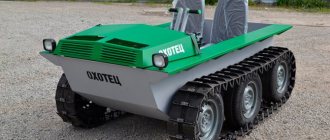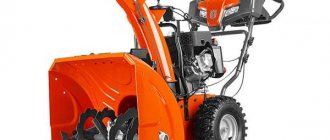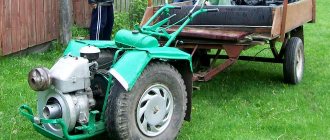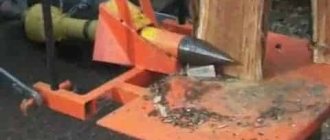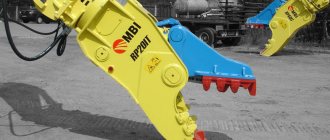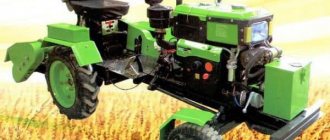Very often, farmers are faced with a problem when they need to buy a loader, but the purchase can cost quite a large sum. If you have enough tools on your farm, as well as quite a lot of metal, you can make your own loader for the rear linkage of the tractor.
Do-it-yourself front loader for a tractor
The loader not only allows you to load equipment, equipment and garbage, but is also capable of leveling the soil in the beds. Similar equipment on the market has a high price. If you have the appropriate tools and materials, you can make a small front loader with your own hands; it will be a good helper for people who are used to working in their summer cottage or have their own farms.
Required materials and tools
Before making a homemade front loader, prepare a drawing in which all the details are drawn. Based on the drawing, prepare the following materials and tools:
- metal profiles and steel sheets (for the bucket);
- cylinder-shaped hinge joints, they are selected in accordance with the drawing and the planned load;
- 3 cylinders;
- powerful welding machine;
- gas cutter or grinder;
- hammer, pliers and various small tools;
- washers and bolts.
The bucket can be purchased at the store or made from metal sheets. The size of the sheets is selected depending on the dimensions of the future structure. The sheet can be bent into a bucket shape or cut using a welding machine. Cylinders for a homemade front loader are removed from the hydraulic system of old equipment. The largest part will regulate the lift of the boom, and the remaining cylinders will regulate the tilt of the bucket.
Making a field sprayer
A homemade sprayer for a walk-behind tractor is necessary in cases where the area of cultivated crops exceeds 20 acres. Doing this type of work manually is very difficult and can take a whole day. Mechanization of this process will save a lot of time and effort.
To make a sprayer you will need:
- welding machine;
- Bulgarian;
- level;
- electric drill;
- soldering iron for polypropylene pipes;
- profile or round water pipes;
- plastic or steel barrel with a capacity of 80-100 l;
- wide pneumatic wheels;
- plastic pipes;
- rubber hose;
- injectors or nipples from wheel tubes.
Design process
If there is no experience and technical skills in assembling various devices, then the work will be difficult to do and will take a lot of time.
But if you stick to the plan, follow the dimensions indicated in the drawing, and work correctly with welding, the equipment will turn out to be of high quality.
The loader is assembled in stages: first, the base is created, then the boom and bucket. Manufacturing of parts and assembly process:
- The basis. To form the base of a homemade front loader, use steel corners or square pipes. The base must be strong and rectangular in shape. It is mounted on the canopy with the bottom side so that its edge protrudes slightly forward. The hydraulic cylinder will be mounted in the center of the frame. An additional triangle made of pipes is mounted under it. The spacer and hinge joints for the boom are located at the top of the base.
- Arrow. The boom is assembled from metal profiles. Their angle should correspond to 30°. The ends of the frame and hydraulic cylinder are mounted at the top of the structure. A cylindrical hinge is installed at the center point of the boom if a mini-loader is assembled. Movable segments are attached to the hinge, which are connected by cylinders and crossbars. Sometimes a large channel is used to make an arrow, but a more reliable design is obtained based on two contours.
- Ladle. The product is assembled from one large steel sheet or several small ones. To do this, rectangular blanks are cut out and welded together so that the front part is located at a slight angle. The length of the boom must be maximum 2 m longer than the loader, otherwise it may tip over. To prevent the homemade product from turning over during operation, this part is equipped with a sinker.
- Assembly process. Steel platforms that provide support for the tools are mounted on the front of the tractor under a canopy. Previously, grooves are made in them for the installation of rods. The boom is made from steel profiles. To do this, profile sections are connected at an angle of 30°, resulting in 2 contours. To make the homemade product durable, the contours are fixed with steel staples. They are installed in the center of the product and along the edges.
When making a loader for a tractor with your own hands, you need to make a protrusion at the top. To do this, a vertical support is installed on one side of the circuit and welded with a welding machine. One side of the spacer is connected to the protrusion, the other to the corner, which is located in the center of the boom.
Eyelets are made on the back side of the bucket. The boom is attached to the bottom eye. Hydraulic cylinders are secured on both sides: one side to the angle, the other to the upper eye of the bucket. Large hydraulic cylinders are transferred from the central section to a support located vertically. Hydraulic cylinders located in the front part of the structure are responsible for rotating the working part of the bucket, and the rear ones allow the boom to bend and extend. The structure is securely attached to the tractor hitch.
Homemade mini loader
Hello! In this topic I would like to condemn the possibility of manufacturing a mini-loader like the PUM 500 or BobCat. These are such small and agile little tractors.
The most important question is how wheel drive is implemented in such loaders.
I myself thought about such a loader, but because there was nothing to do with it, I abandoned the idea. Here is a link: a person sold a homemade one a year ago. https://rst.ua/oldcars/specialtech/loader/specialtech_loader_1123497.html
And watch the video, there are assembly elements and you can see how everything works https://www.youtube.com/watch?v=MoXUlgdr1uw
My channel - https://www.youtube.com/user/pppatriot You are welcome to join the viber group “Farmers of Ukraine”, write in private.
The most important question is how wheel drive is implemented in such loaders.
Wheel drive via GST hydrostatics with an adjustable pump.
My channel - https://www.youtube.com/user/pppatriot You are welcome to join the viber group “Farmers of Ukraine”, write in private.
Plants grow for us, and we do not live to care for them. The more people I get to know, the more I love animals.
The most important question is how wheel drive is implemented in such loaders.
Wheel drive via GST hydrostatics with an adjustable pump.
The power plant (diesel) turns 3. nsh 50, 2 nsh per onboard drive 1 respectively per boom. On board there are reversible hydraulic motors, the right-left side has separate hydraulic camshafts.
There is an alternative, it won’t be as agile as the PUM, but it will do the job of a loader. There was such an idea, two UAZ front axles, a clutch + gearbox + a UAZ transfer case, an OKA engine, between the motor and the clutch there was a 1/3 gearbox to drive the hydraulic pump and, accordingly, a 1/3 clutch. The steering is on a dispenser, the front and rear axles are pulled through an industrial support so that the wheels turn synchronously in different directions. The brakes are separate right and left. In short, I calculated the costs (there is a UAZ to disassemble) on hydraulics, and spat. A couple of K-20v appeared on the farm, and I put a frontal on one of them.
Walk-behind tractor: search for other spare parts
Borrowing engines from passenger vehicles is convenient because the corresponding equipment may have the necessary gearbox and transmission. Then the enthusiast needs to adjust the wheeled chassis and frame to the “mechanics” and the power plant, and not vice versa, which is much more difficult.
To make wheels that will support a walk-behind tractor, you can use:
- Brake drums;
- Car wheels "Zhiguli".
Do-it-yourself front loader for a mini tractor
There is a desire to make a front loader for the Scout T-15 mini tractor. The rear linkage was done in a hurry
likeness to him. Helps out around the house, but with limitations. I want more. I would like to hear opinions, advice, experience in using and building this unit. Mounting options, etc. and so on.
Structurally, I propose to make it this way with some changes and modifications.
Anatoly Psk wrote: There is a desire to make a front loader for the Scout T-15 minitractor. The rear linkage was done in a hurry
likeness to him. Helps out around the house, but with limitations. I want more. I would like to hear opinions, advice, experience in using and building this unit. Mounting options, etc. and so on.
Anatoly Psk, in the KMZ topic I posted something similar, but with the replacement of the central valve with a hydraulic cylinder, it turns out to be a little more functional but also more expensive. On the positive side I have:
- My design does not torment the standard HC when the bucket is fully loaded, since the levers are lowered to the bottom as much as possible, and the central hydraulic cylinder turns the bucket towards itself with the load in the lower position. This is important for KMZ, since the standard GC is fragile.
- The bucket itself is made of 3 mm metal, while it is lighter and has sufficient strength. Otherwise, I like everything about your design, except for sharpening the edge on the bucket.
Anatoly Psk, congratulations! Looking at the frame of my Scout-12, I see a weak point in the connection between the frame and the ZM gearbox housing. It seems to me that it needs to be strengthened with a three-dimensional design.
Anatoly Psk wrote: Structurally, I propose to make it like this with some changes and modifications
This front in the video was made stupidly, i.e. The design seems to be correct, but imagine riding around the yard with such an arrow. It would be correct to make the vertical stand higher, around 1-1.3 m, and the boom will fold and the size will be much more compact, similar to a rear-mounted loader. I also made a rear-mounted loader like this a long time ago.
A small clarification. The unit is planned for the front linkage. And in the photo it was made hastily from what was at hand, to solve pressing problems instead of a wheelbarrow and a shovel. This option will live until the adult KUN is made
pelipenko, the option is not bad. But not for Scout. The frame at the rear of the Scout is missing. It ends at the feet. Next, fasten the adapted walk-behind tractor. You can't attach it to it - it will fall apart. I'm planning a similar design for the front. And precisely with a tiltable supporting frame. But also additionally strengthening the frame itself. It's a bit flimsy on the Scout. He turns it under the jack.
Anatoly Psk wrote: The unit is planned for a front linkage.
I understood everything, but you need to make the stance higher and the arrow will be closer. And the loading height will increase.
Warm salam to everyone! But I prefer the design of a lift with a vertical mast on the face.
I will try to attach legs to this stacker. If it doesn't work out, I'll do something similar. You can hang anything - a bucket, a boom for a crane and grab, a drill, a bulldozer blade and a bunch of other metal crap.
KMZ-012ch 2004 5+1
Anatoly Psk, Where is the center of mass of this tractor?
My thoughts are only in my head. Oh, I’ll take the swarm to the dacha, and for the weekend.
Sanych53 wrote: Fiery salam to everyone! But I prefer the design of a lift with a vertical mast on the face.
I will try to attach legs to this stacker. If it doesn't work out, I'll do something similar. You can hang anything - a bucket, a boom for a crane and grab, a drill, a bulldozer blade and a bunch of other metal crap.
Sanych53, this thing is a bit heavy considering that the front of the tractor is rather weak. The GP of this installation (pictured) is no less than a ton, and we have the ability to take up to 100 kg in a ladle - why such a safety margin. I like the previous loader for its simplicity and at the same time light weight, plus its boom is obtained by lifting the outrigger, which expands its loading capabilities with a smaller size and weight of the installation. Here is a video of my vision of the device:
Do-it-yourself attachments for a mini tractor
A mini tractor is an indispensable device for a small farm or suburban area. To increase the efficiency of working with it, you should use various attachments. The best way to save money is to make your own attachments for a mini tractor.
The following types of attachments are most often used on the farm:
- universal mounted bucket (KUN);
- front loader;
- excavator bucket;
- blade or shovel.
What these tools are needed for and how to make them yourself will be discussed below.
Walk-behind tractor: search for power plant
The simple design of the walk-behind tractor allows you to assemble it from scratch, borrowing various parts from donor units.
For example, the following have proven themselves well as a power plant:
- Chainsaw motor;
- Engine from small and medium-sized motorcycles - “Ant”, “Riga”, “IZH”, “Dnepr”;
- Engine from ZAZ, VAZ cars.
The first option produces power that is more akin to a cultivator, and not like a video on how to make a walk-behind tractor with your own hands, where a large unit sets the rhythm for equally large wheels.
Therefore, when choosing a power plant for a future walk-behind tractor, you must be guided by the area that it will have to process.
Universal mounted bucket
A homemade KUHN for a mini tractor is one of the types of front loaders. It is indispensable when you need to transport or load large volumes of bulk (and other) materials, such as sand, crushed stone or grain.
The mini tractor itself differs in size from a full-fledged tractor. Using a bucket allows you to turn a simple tractor into a universal vehicle for a wide variety of types of work.
Front loaders have a number of advantages:
- easy maintenance;
- reliability;
- ease of installation and dismantling of equipment;
- serious load capacity for a small-sized tractor;
- ease of control due to enhanced hydraulics.
Making a ladle
You can buy a bucket for a mini tractor at any hardware store, but this is not the cheapest pleasure, so it’s easier to make it yourself. You don't need any special knowledge or materials here. To work, you need to stock up on drawings, a grinder, a welding machine and the material itself.
- First you need to make the fasteners. It is welded to the box and engine, and a metal corner is welded underneath for reinforcement.
- The KUN itself is made from pieces of sheet metal. There is no point in bending the sheet to fit the shape of the ladle. It is much easier to cut rectangles of the required size and weld them together to form a ladle. The durability of the product depends on the quality of the seams. It is better to use pipes with a diameter of 100 mm for racks, and 50 mm for rods.
- The next stage is the installation of the hydraulic booster. For greater mobility, it is recommended to use a pipe with a diameter of 30 mm (it should not be more than 50 mm, otherwise the pipes will not move well inside each other).
- Now the support is welded to the front of the tractor and combined with the racks; gussets are used for reinforcement.
- A cylinder is used to control the rotation of the bucket. It is usually installed to the right of the bucket.
Front loader
A homemade loader consists of three main elements:
- ladle;
- hydraulic lifting mechanism;
- bucket mounting and control system.
Important! When making a loader for a mini tractor with your own hands, you need to make sure that the weight of the hitch matches the weight of the tractor itself. Otherwise, when loaded, the loaded bucket may overweight the tractor and cause injury.
First of all, you should make a bucket. This is not the hardest task. It is welded from pieces of metal plates, the thickness of which should not be less than 6 mm. Triangles are welded on the sides to cover the sides of the bucket. Weld special ridges longitudinally to the lower part, which will facilitate the capture of materials.
The second stage of front loader assembly is the hydraulic lift system. To make it you will need 4 levers, a boom and 4 hydraulic lifts. It is better to immediately purchase ready-made lifts. A square pipe with the required cross-section is suitable for the levers, and a U-shaped channel can be used for the boom. On one side it is connected to the bucket, and on the other to the mini tractor.
In addition, various connecting elements will be needed. When assembling, you need to correctly calculate the center of gravity, otherwise, when working with a front loader, the equipment may tip over.
In the figure: 1 - bucket, 2 - levers, 4 - boom, 5 and 6 - hydraulic lifts, 7 - attachment to the tractor, 3 - position of the front wheel (the center of gravity should be here).
When assembling any mounted unit, the most important point is to comply with all proportions; deviation from the plan can lead to bad consequences.
Excavator bucket
You can make a mounted excavator on a mini tractor by analogy with a front loader. The fundamental difference is the shape of the bucket, as well as the boom, which will consist of two parts.
To make the boom, you will need two square metal pipes connected to each other in the shape of the letter L. The pipe on which the bucket will be attached must be longer than the pipe attached to the tractor. A hydraulic lift is connected to the protrusion located on top - it will move the boom on which the bucket is attached. The second lift ensures the movement of the boom attached to the mini tractor. The third is responsible for the movement of the bucket itself. It can be made stationary, but for greater efficiency during excavation work you need to be able to control not only the booms, but also the bucket.
The figure shows an approximate size calculation; each specific case uses its own. Thick black lines are hydraulic lifts.
The bucket itself differs from the front loader in size - it must be narrower and stronger, since it will have to blast the ground. For manufacturing, you can use sheet metal with a thickness of 6 mm; it is important to firmly weld the pins to loosen the earth. In general, this unit should be more massive, unlike a loader bucket.
Walk-behind tractor: device
The thematic unit is a wheeled chassis on which an engine with a power of up to 14 hp is placed. The motor is powered by diesel or gasoline to set the chassis speed through the gearbox.
As a result, the user of the walk-behind tractor effortlessly pushes the equipment forward, holding it by the handles. The latter houses the start and speed buttons.
The chassis of the walk-behind tractor consists of two wheel axles with thick tires. In winter, it is better to equip tires with chains so that the unit does not slip on snow and ice.
But for better maneuverability on wet ground, it is recommended to replace axles with tires with metal lugs.
An alternative option is a caterpillar track. But then the question arises: “how to make tracks on a walk-behind tractor with your own hands and what materials and means to use for this?”
To make themed caterpillars, enthusiasts use:
- Conveyor belt and links cut from a profile pipe;
- Split tires from cars and other transport equipment.
This explains the need to use a grinder for sawing metal and cutting tires. You will also need pneumatic tools for cutting in fasteners.
Blade
A mini tractor blade is another indispensable unit when working on a small farm. With its help, you can level the area, remove snow and perform many other tasks.
A homemade dump can be made from a piece of steel pipe with a diameter of at least 70 cm and a wall thickness of 8 mm; an old heating boiler or barrel will also work. To make a blade for a mini tractor, you need to cut the pipe longitudinally, but this should not be done in the middle, but approximately three-quarters of the full circumference. This creates the perfect curve for gripping.
When making a shovel for a mini tractor, you need to take into account its power and dimensions in order to choose the right width. It is not recommended to make the blade wider than the tractor by more than 20 cm on each side.
To strengthen the blade, it is necessary to make a longitudinal stop, for which a square pipe measuring 4*4 cm is ideal. In addition, it is recommended to make vertical stops in the amount of 4-8 pieces. It is best to attach the longitudinal stop just below the center of the shovel, and provide its lower edge with a rubber casing to protect it from damage when it comes into contact with a hard surface, for example, asphalt or concrete. Another important element is the knife, which is welded to the bottom edge. It can be made from a metal plate 5 mm thick and long, corresponding to the width of the shovel. To attach the cuff, holes with a diameter of 5-6 mm should be drilled every 10 cm.
You need to install the shovel on a welded structure that resembles the letter A. In the place where the middle jumper is located, you should weld a special bracket for attaching the hitch to the tractor. The lifting of the shovel will be provided by a hydraulic unit, which is best purchased immediately in the store.
Application area
Of course, the power of a homemade unit may be somewhat weaker, but at the level of domestic use this fact is almost unnoticeable.
The main area of application of this DIY unit is agricultural work. This term covers a fairly wide spectrum, including many related works. In other words, a homemade mini tractor is needed for the following purposes:
- plowing of land holdings for the purpose of their further use;
- cultivating the soil and getting rid of weeds;
- harrowing the soil;
- carrying out sowing work on treated soil;
- planting and digging potatoes.
In principle, this is the main purpose of a mini tractor, for which it is made. But, its application can be significantly expanded if a special connection for additional equipment, mounted and trailed, is provided in its design.
If everything is done correctly, then your homemade product can additionally perform the following work:
- transportation of various goods (transportation of firewood, construction waste, etc.);
- snow removal in winter;
- mowing lawns and lawns, as well as making hay for livestock.
As we can see, a mini tractor breaking a classic 4x4 with your own hands can significantly make the life of any rural resident easier, because with the help of this equipment it becomes possible to perform all types of work that are required for proper management of a subsidiary farm.
The indispensability of a home-made unit is also due to the fact that its production uses a minimum of investments and funds, which is very important for rural areas.
For more information about the operation of an all-wheel drive mini tractor, see
